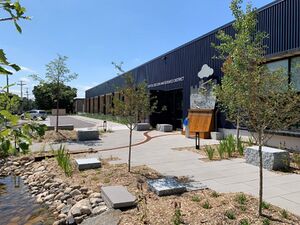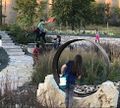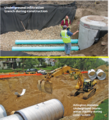
Difference between revisions of "Category:Level 3 - Case studies and examples/Case studies/Green infrastructure"
m |
m |
||
| Line 1: | Line 1: | ||
| + | [[File:Capitol Region Watershed District HQ 2.jpg|300px|thumb|alt=image of entrance to building where the capitol region watershed district is located|<font size=3>Interactive watershed exhibit in CRWD’s neighborhood pocket park</font size>]] | ||
| + | |||
| + | <span title="Green Infrastructure refers to ecological systems, both natural and engineered, that act as living infrastructure. Green Infrastructure elements are planned and managed primarily for stormwater control, but also exhibit social, economic and environmental benefits (Syracuse University)."> '''Green infrastructure'''</span> encompasses a wide array of practices, including stormwater management. <span title="Green stormwater infrastructure (GSI) describes practices that use natural systems (or engineered systems that mimic or use natural processes) to capture, clean, and infiltrate stormwater; shade and cool surfaces and buildings; reduce flooding, create wildlife habitat; and provide other services that improve environmental quality and communities’ quality of life. (City of Tucson)"> '''Green stormwater infrastructure'''</span> (GSI) encompasses a variety of practices primarily designed for managing stormwater runoff but that provide additional benefits such as habitat or aesthetic value. | ||
| + | |||
| + | Water management using green infrastructure practices mimics the natural <span title="The water cycle, also known as the hydrologic cycle or the hydrological cycle, describes the continuous movement of water on, above and below the surface of the Earth."> '''water cycle'''</span>. Examples of green infrastructure practices include planting trees, restoring wetlands, enhancing biodiversity, and restoring floodplains. Green infrastructure incorporates both the natural environment and engineered systems to provide clean water, conserve <span title="Ecosystem values are measures of how important ecosystem services, such as pollination, nutrient cycling, and climate regulation, are to people – what they are worth."> '''ecosystem values'''</span> and functions, and provide a wide array of benefits to people and wildlife. Green infrastructure can be applied on different scales, from the house or building level, to the broader landscape level. On the local level, green infrastructure practices include rain gardens, permeable pavements, green roofs, infiltration planters, trees and tree boxes, and rainwater harvesting systems. At the largest scale, the preservation and restoration of natural landscapes (such as forests, floodplains and wetlands) are critical components of green infrastructure. | ||
| + | |||
| + | Stormwater management using green infrastructure practices involves keeping and using water close to its point of origin (i.e. keeping the raindrop where it falls). Practices include those local practices mentioned above - [https://stormwater.pca.state.mn.us/index.php?title=Bioretention rain gardens], [https://stormwater.pca.state.mn.us/index.php?title=Permeable_pavement permeable pavements], [https://stormwater.pca.state.mn.us/index.php?title=Green_roofs green roofs], [https://stormwater.pca.state.mn.us/index.php?title=Stormwater_infiltration_Best_Management_Practices infiltration] planters, [https://stormwater.pca.state.mn.us/index.php?title=Trees trees] and tree boxes, and [https://stormwater.pca.state.mn.us/index.php?title=Stormwater_and_rainwater_harvest_and_use/reuse rainwater harvesting systems]. Because there multiple benefits of these practices, in addition to stormwater management, the manual includes a variety of topics related to green infrastructure as illustrated below. | ||
| + | |||
This page provides links to pages that provide case studies of green infrastructure and green infrastructure projects. | This page provides links to pages that provide case studies of green infrastructure and green infrastructure projects. | ||
[[Category:Level 2 - Case studies and examples/Case studies]] | [[Category:Level 2 - Case studies and examples/Case studies]] | ||
[[Category:Level 2 - Management/Green infrastructure]] | [[Category:Level 2 - Management/Green infrastructure]] | ||
Latest revision as of 01:30, 8 February 2023
Green infrastructure encompasses a wide array of practices, including stormwater management. Green stormwater infrastructure (GSI) encompasses a variety of practices primarily designed for managing stormwater runoff but that provide additional benefits such as habitat or aesthetic value.
Water management using green infrastructure practices mimics the natural water cycle. Examples of green infrastructure practices include planting trees, restoring wetlands, enhancing biodiversity, and restoring floodplains. Green infrastructure incorporates both the natural environment and engineered systems to provide clean water, conserve ecosystem values and functions, and provide a wide array of benefits to people and wildlife. Green infrastructure can be applied on different scales, from the house or building level, to the broader landscape level. On the local level, green infrastructure practices include rain gardens, permeable pavements, green roofs, infiltration planters, trees and tree boxes, and rainwater harvesting systems. At the largest scale, the preservation and restoration of natural landscapes (such as forests, floodplains and wetlands) are critical components of green infrastructure.
Stormwater management using green infrastructure practices involves keeping and using water close to its point of origin (i.e. keeping the raindrop where it falls). Practices include those local practices mentioned above - rain gardens, permeable pavements, green roofs, infiltration planters, trees and tree boxes, and rainwater harvesting systems. Because there multiple benefits of these practices, in addition to stormwater management, the manual includes a variety of topics related to green infrastructure as illustrated below.
This page provides links to pages that provide case studies of green infrastructure and green infrastructure projects.
Pages in category "Level 3 - Case studies and examples/Case studies/Green infrastructure"
The following 8 pages are in this category, out of 8 total.
C
G
Media in category "Level 3 - Case studies and examples/Case studies/Green infrastructure"
The following 24 files are in this category, out of 24 total.
- Allianz Field tree trench 1.jpg 3,024 × 4,032; 3.49 MB
- Allianz field tree trench 2.jpg 3,264 × 2,448; 2.25 MB
- Allianz Field tree trench 3.jpg 3,264 × 2,448; 1.67 MB
- Allianz field tree trenches.png 1,418 × 604; 1.86 MB
- Allianz Field undergroun tanks 1.jpg 1,112 × 747; 321 KB
- Allianz.jpg 710 × 314; 48 KB
- Alliianz Field underground tanks 2.jpg 1,319 × 811; 349 KB
- Arlington bmps.png 505 × 1,134; 1.68 MB
- Capitol Region Watershed District HQ 1.jpg 739 × 470; 119 KB
- Capitol Region Watershed District HQ 2.jpg 960 × 720; 250 KB
- Capitol Region Watershed District HQ 3.jpg 638 × 478; 146 KB
- Capitol Region Watershed District HQ 4.jpg 598 × 478; 102 KB
- Capitol Region Watershed District HQ 5.jpg 558 × 558; 102 KB
- Dakotah green roof and solar panels.jpg 766 × 511; 176 KB
- Dakotah green roof and veg.jpg 766 × 511; 214 KB
- Dakotah green roof construction.jpg 766 × 511; 101 KB
- Dakotah permeable pavers and rain garden.jpg 681 × 511; 154 KB
- Maplewood Mall GSI.jpg 663 × 373; 111 KB
- Ramsey washington living streets rain garden.jpg 1,080 × 718; 307 KB
- Towerside figure 1.jpg 649 × 411; 102 KB
- Towerside figure 2.jpg 468 × 334; 60 KB
- Towerside figure 3.jpg 975 × 875; 293 KB
- Towerside figure 4.jpg 975 × 731; 272 KB
- Underground infiltration.png 901 × 991; 2.43 MB
This page was last edited on 8 February 2023, at 01:30.
























